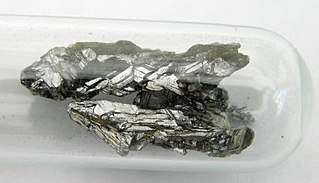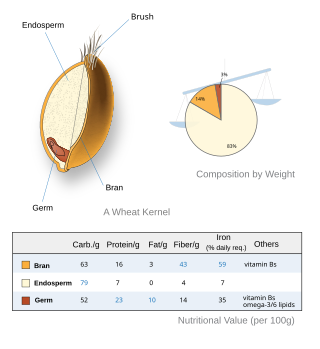Related Research Articles

Arsenic is a chemical element with the symbol As and atomic number 33. Arsenic occurs in many minerals, usually in combination with sulfur and metals, but also as a pure elemental crystal. Arsenic is a metalloid. It has various allotropes, but only the grey form, which has a metallic appearance, is important to industry.

Nitrate is a polyatomic ion with the chemical formula NO−
3. Salts containing this ion are called nitrates. Nitrates are common components of fertilizers and explosives. Almost all inorganic nitrates are soluble in water. An example of an insoluble nitrate is bismuth oxynitrate.

Thiamine, also known as thiamin and vitamin B1, is a vitamin, an essential micronutrient for humans and animals. It is found in food and commercially synthesized to be a dietary supplement or medication. Phosphorylated forms of thiamine are required for some metabolic reactions, including the breakdown of glucose and amino acids.

Vitamins are organic molecules that are essential to an organism in small quantities for proper metabolic function. Essential nutrients cannot be synthesized in the organism in sufficient quantities for survival, and therefore must be obtained through the diet. For example, Vitamin C can be synthesized by some species but not by others; it is not considered a vitamin in the first instance but is in the second. Most vitamins are not single molecules, but groups of related molecules called vitamers. For example, there are eight vitamers of vitamin E: four tocopherols and four tocotrienols.

Pantothenic acid (vitamin B5) is a B vitamin and an essential nutrient. All animals need pantothenic acid in order to synthesize coenzyme A (CoA)—essential for metabolizing fatty acid—and to synthesize and metabolize proteins, carbohydrates, and fats.

Dietary fiber or roughage is the portion of plant-derived food that cannot be completely broken down by human digestive enzymes. Dietary fibers are diverse in chemical composition, and can be grouped generally by their solubility, viscosity, and fermentability, which affect how fibers are processed in the body. Dietary fiber has two main components: soluble fiber and insoluble fiber, which are components of plant-based foods, such as legumes, whole grains and cereals, vegetables, fruits, and nuts or seeds. A diet high in regular fiber consumption is generally associated with supporting health and lowering the risk of several diseases. Dietary fiber consists of non-starch polysaccharides and other plant components such as cellulose, resistant starch, resistant dextrins, inulin, lignins, chitins, pectins, beta-glucans, and oligosaccharides.
Vitamin deficiency is the condition of a long-term lack of a vitamin. When caused by not enough vitamin intake it is classified as a primary deficiency, whereas when due to an underlying disorder such as malabsorption it is called a secondary deficiency. An underlying disorder can have 2 main causes:
Fluoride is an inorganic, monatomic anion of fluorine, with the chemical formula F−
, whose salts are typically white or colorless. Fluoride salts typically have distinctive bitter tastes, and are odorless. Its salts and minerals are important chemical reagents and industrial chemicals, mainly used in the production of hydrogen fluoride for fluorocarbons. Fluoride is classified as a weak base since it only partially associates in solution, but concentrated fluoride is corrosive and can attack the skin.

In the context of nutrition, a mineral is a chemical element. Some "minerals" are essential for life, most are not. Minerals are one of the four groups of essential nutrients, the others of which are vitamins, essential fatty acids, and essential amino acids. The five major minerals in the human body are calcium, phosphorus, potassium, sodium, and magnesium. The remaining elements are called "trace elements". They are iron, chlorine, cobalt, copper, zinc, manganese, molybdenum, iodine, and selenium.

Bran, also known as miller's bran, is the hard layers of cereal grain surrounding the endosperm. It consists of the combined aleurone and pericarp. Corn (maize) bran also includes the pedicel. Along with the germ, it is an integral part of whole grains, and is often produced as a byproduct of milling in the production of refined grains.

Parboiled rice is rice that has been partially boiled in the husk. The three basic steps of parboiling are soaking, steaming and drying. These steps make the rice easier to process by hand, while also boosting its nutritional profile, changing its texture, and making it more resistant to weevils. The treatment is practiced in many parts of the world.
Isoflavones are substituted derivatives of isoflavone, a type of naturally occurring isoflavonoids, many of which act as phytoestrogens in mammals. Isoflavones are produced almost exclusively by the members of the bean family, Fabaceae (Leguminosae).

A whole grain is a grain of any cereal and pseudocereal that contains the endosperm, germ, and bran, in contrast to refined grains, which retain only the endosperm.
Copper gluconate is the copper salt of D-gluconic acid. It is an odorless light blue or blue-green crystal or powder which is easily soluble in water and insoluble in ethanol.

Arsenic contamination of groundwater is a form of groundwater pollution which is often due to naturally occurring high concentrations of arsenic in deeper levels of groundwater. It is a high-profile problem due to the use of deep tube wells for water supply in the Ganges Delta, causing serious arsenic poisoning to large numbers of people. A 2007 study found that over 137 million people in more than 70 countries are probably affected by arsenic poisoning of drinking water. The problem became a serious health concern after mass poisoning of water in Bangladesh. Arsenic contamination of ground water is found in many countries throughout the world, including the US.
Potassium arsenite (KAsO2) is an inorganic compound that exists in two forms, potassium meta-arsenite (KAsO2) and potassium ortho-arsenite (K3AsO3). It is composed of arsenite ions (AsO33− or AsO2−) with arsenic always existing in the +3 oxidation state. Like many other arsenic containing compounds, potassium arsenite is highly toxic and carcinogenic to humans. Potassium arsenite forms the basis of Fowler’s solution, which was historically used as a medicinal tonic, but due to its toxic nature its use was discontinued. Potassium arsenite is still, however, used as a rodenticide.

Manganese is an essential biological element in all organisms. It is used in many enzymes and proteins. It is essential in plants.
Fibre supplements are considered to be a form of a subgroup of functional dietary fibre, and in the United States are defined by the Institute of Medicine (IOM). According to the IOM, functional fibre "consists of isolated, non-digestible carbohydrates that have beneficial physiological effects in humans".

Oat β-glucans are water-soluble β-glucans derived from the endosperm of oat kernels known for their dietary contribution as components of soluble fiber. Due to their property to lower serum total cholesterol and low-density lipoprotein cholesterol, and potentially reduce the risk of cardiovascular diseases, oat β-glucans have been assigned a qualified health claim by the European Food Safety Authority and the US Food and Drug Administration.
Eureka Emefa Ahadjie Adomako is a Ghanaian botanist and academic who is currently a senior lecturer at the Department of Plant and Environmental Biology, University of Ghana. Adomako served as the quiz mistress of the Ghana National Science and Maths Quiz (NSMQ) from 2001 to 2005.
References
- ↑ Lorraine Heller (August 26, 2008). "Rice bran contains high arsenic levels, study".
- ↑ Catherine Brahic (August 22, 2008). "Superfood rice bran contains arsenic". New Scientist.
- ↑ Zhu, Yong-Guan; Williams, Paul N.; Meharg, Andrew A. (2008). "Exposure to inorganic arsenic from rice: A global health issue?". Environmental Pollution. 154 (2): 169–71. doi:10.1016/j.envpol.2008.03.015. PMID 18448219.
- ↑ US 6303586,McPeak, Patricia; Cheruvanky, Rukmini& Cherukuri, Reddy Sastry V.,"Supportive therapy for diabetes, hyperglycemia and hypoglycemia",published 2001-10-16, assigned to The RiceX Co.
- 1 2 3 Sun, G. X.; Williams, P. N.; Carey, A. M.; Zhu, Y. G.; Deacon, C; Raab, A; Feldmann, J; Islam, R. M.; Meharg, A. A. (2008). "Inorganic arsenic in rice bran and its products are an order of magnitude higher than in bulk grain". Environmental Science & Technology. 42 (19): 7542–6. Bibcode:2008EnST...42.7542S. doi:10.1021/es801238p. PMID 18939599.
- ↑ Carbonell-Barrachina, Ángel; Munera-Picazo, Sandra; Cano-Lamadrid, Marina; Burló, Francisco; Castaño-Iglesias, María Concepción (2015). "Arsenic in your food: Potential health hazards from arsenic found in rice". Nutrition and Dietary Supplements: 1. doi: 10.2147/NDS.S52027 .
- ↑ Meharg, Andrew A.; Lombi, Enzo; Williams, Paul N.; Scheckel, Kirk G.; Feldmann, Joerg; Raab, Andrea; Zhu, Yongguan; Islam, Rafiql (2008). "Speciation and Localization of Arsenic in White and Brown Rice Grains". Environmental Science & Technology. 42 (4): 1051–7. Bibcode:2008EnST...42.1051M. doi:10.1021/es702212p. PMID 18351071.